BIRDS OF PREY
Order
Falconiformes (vultures, ospreys, hawks,
falcons)
|
 Family
Accipitridae Family
Accipitridae
Cooper’s Hawk
Accipiter
cooperii
A medium
sized bird with a long, lean body. A swift flyer with a hooked
beak. This hawk is noted as a predator of other birds, as well as
also mammals. The female is about 42-50 cm and the male is slightly
smaller. In flight the Cooper’s hawk exhibits a long barred tail
and short, rounded wings. |
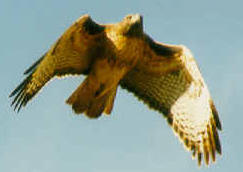 Family Accipitridae Family Accipitridae
Red Shouldered Hawk
Buteo lineatus
This predator
eats small mammals, reptiles, amphibians, and small birds. It is a
large broad-winged hawk with a relatively long tail. The female is
larger than the male. A brown head and reddish upper wings are
characteristic of this species. The tail is dark brown with white
bands. It has sharp eyesight with excellent depth perception.
Females lay 3-4 whitish eyes with brown blotches. |
 Family
Cathartidae Family
Cathartidae
Turkey Vulture
Cathartes aura
Turkey vultures
are large eagle-like birds, with 2-toned blackish wings and small
red naked heads. They have a longish, hooked bill with short, thick
legs. “Kettles” of vultures are often seen soaring in wide circles
with their wings held in a “V” position (dihedral). They ride
thermals of rising air and seldom flap their wings as they soar in
the sky. Vultures feed on the flesh of dead animals (carrion)
including
that of small mammals, birds, reptiles, amphibians, and fish.
|
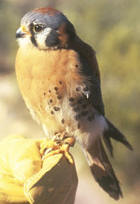 Family
Falconidae Family
Falconidae
American Kestrel
Falco
sparverius
The American kestrel is the
smallest and most common of our falcons. It has a russet back and
tail, and two black stripes on a white face. The male has blue-gray
wings. Kestrels feed on insects, small reptiles and mammals and
hover over their prey before plunging to seize them in their
talons. They were formerly called sparrow hawks because they may
feed on small birds in winter. Their call is a shrill, loud
killy killy killy. |
|
Order Strigiformes
(owls) |
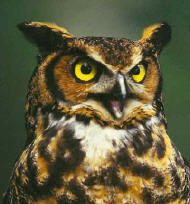 Family
Strigidae Family
Strigidae
Great Horned Owl
Bubo virginianus
Distinct catlike
ears and eyes with a feathered tuft on head that resembles a horn.
Upper body is brown with gray brown mottling. Average length is
about 64 cm with a 1.4-meter wingspan. Considered a ferocious
predator hunting on small mammals, birds, and crayfish. It
regurgitates the unwanted parts of its prey. Uses abandon nest of
hawks or crows. |
PERCHING BIRDS,
SONGBIRDS
Order Passeriformes
(flycatchers, swallows, jays, chickadees, nutcrackers, thrushes,
wrens, starlings, warblers, sparrows, finches) |
|
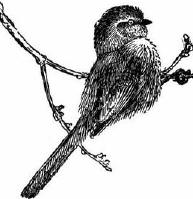 Family
Aegithalidae Family
Aegithalidae
Bushtit
Psaltriparus minimus
High thin, fussing notes and
constant twittering and fluttering in the trees announce the arrival
of a flock of insect-eating bushtits. They are gray above with
brownish cheeks, whitish below, and have a long tail and short
bill. Approximately 11 cm in length. Feeds on aphids, spiders, and
other insect as well as seeds and fruits. The nest is a long woven
sock hung from a branch that usually contains 5-7 white eggs. Eggs
incubate in 12 days and young fledge in 14-15 days. Common in
California. |
|
 Family Corvidae Family Corvidae
Western Scrub-Jay
Aphelocoma californica
The crestless
scrub jay has a blue head, wings and tail, a brownish back, white
throat, and a necklace of short streaks across the breast. Its
rough rasping shreek often announces the presence of an
intruder into its habitat. It has an oak woodland habitat. It lays
3-6 reddish or green spotted eggs in a twiggy bowl located in a bush
or low tree. |
|
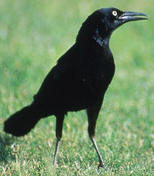 Family Corvidae Family Corvidae
American Crow
Corvus brachyrhynchos
Large black bird that is slightly iridescent
blue and purple about 45 cm long with a 90 cm wingspan. Tail is fan
shaped and slightly rounded. Nest is coarsely but well made with
sticks, twigs and grass. They have 4-7 blue green to greenish white
mottled and speckled eggs that are about 41 mm in length. This
omnivore eats grains, seeds, insects, frogs and human scraps. It
gives a caw-caw or caa-caa sound. |
|
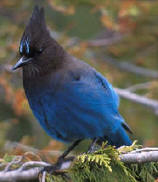 Family Corvidae Family Corvidae
Steller's Jay
Cyanocitta stelleri
A jay with black
crest with deep blue belly with black breast. It has a length of
30-34 cm and a wingspan of 45-48 cm. It has a thick, pointed
bill. Its song is chook-chook chook or shack-shack-shack.
This omnivore eats nuts, seeds and acorns, and some invertebrates.
It also eats the eggs of other birds. It is monogamous with
clutches of 2-6 eggs in cup shaped nests. |
|
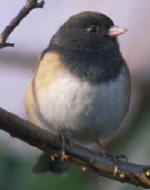 Family
Emberizidae Family
Emberizidae
Dark-eyed Junco
Junco hyemalis
Gray sparrow with white
outer tail feathers and white breast. It breeds in brushy areas.
It is an omnivore that eats seeds, insects and some fruits. Has a
pink conical bill. The female is somewhat browner |
|
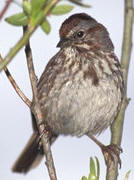 Family
Emberizidae Family
Emberizidae
Song Sparrow
Melospiza melodia
The song
sparrow is brown with a heavy streaked breast and a central dark
“stickpin.” Its legs and feet are pinkish. It pumps its long,
rounded tail in flight. It inhabits dense streamside thickets and
moist wood margins. Its song is a series of variable musical and
buzzy notes: sweet, sweet, sweet. Its call note is a hollow
chimp. It lays 3-5 spotted eggs in a grass cup on the ground
or in a bush. |
|
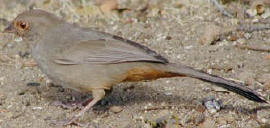 Family Emberizidae Family Emberizidae
California Towhee
Pipilo crissalis
The California towhee is
dull brown above, paler below, and has a dark buff colored streaked
throat. It has a long tail with rusty orange under tail coverts.
This common bird hops while feeding on the ground near dense
shrubbery. Its call is a metallic chink. The cup nest is
built in a bush or tree and contains 3-4 spotted eggs. |
|
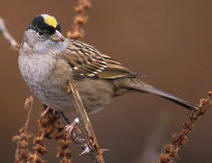 Family Emberizidae Family Emberizidae
Golden-crowned Sparrow
Zonotrichia atricapilla
Medium sized
bird with a long tail and a yellow crown. Feeds on seeds, nuts, and
insects. It has a dark conical bill. Its face and under parts are
gray. Wings are brownish. |
|
 Family Emberizidae Family Emberizidae
White-crowned Sparrow
Zonotrichia leucophrys
Distinctive
black stripe that extends along the crown of head and behind eyes.
It outlines white feathers on top of its head.
Its
breast is light gray with dark brown flight feathers. Mainly eats
seeds, grass, buds and fruit.
|
|
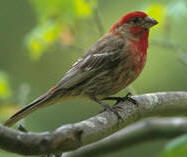 Family Fringillidae Family Fringillidae
House Finch
Carpodacus
mexicanus
Small bird
about 14 cm in length. Male is rosy pink on throat and rump, while
female is gray-streaked brown. They eat seeds from thistle and
dandelion as well as fruit such as cherries. Nest is made of grass
as a shallow cup. A clutch is 3-6 bluish or greenish white eggs. |
|
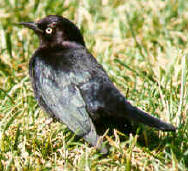 Family Icteridae Family Icteridae
Brewer’s Blackbird
Euphagus
cyanocephalus
The Brewer’s
blackbird male has a black body that in certain light can reflect
purple on the head and green on the body. The eye of the male is
white. The female is a brown gray color and has brown eyes. These
birds generally occur in pairs even when with a flock. They feed on
insects, seeds, and fruits found in the surrounding area. |
|
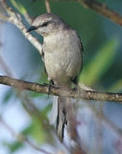 Family Mimidae Family Mimidae
Northern Mockingbird
Mimus polyglottos
Long
tail with gray feathers above and paler gray to white below with
white wing bars. This perching bird has a gray back and pale
underside. It has white wing patches that are noticeable during
flight. The long tail has white outer feathers. Its song is a
mixture of imitated songs and calls that may continue into the night
hours. Commonly found in thickets and shrubs along creek margins.
About 30 cm long. |
|
 Family Paridae Family Paridae
Chestnut-backed Chickadee
Poecile rufescens
The chestnut-backed
chickadee has a brown cap, white cheeks, and a black bib. It is
about 13 cm with a small body and long tail. It is an omnivore
eating seeds, spiders, caterpillars and many other insects. It
feeds high in trees, sometimes hanging upside down. Its call is a
hoarse, rapid tseek-a-dee-dee. It lays 5-7 dotted eggs in a
cavity of a tree or stump. It is a social bird traveling in flocks
with creepers, woodpeckers, and kinglets. |
|
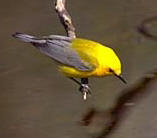 Family Parulidae Family Parulidae
Yellow-rumped Warbler
Dendroica coronata
A
warbler with a yellow rump with yellow patches on its sides. During
mating the male and female have yellow crown patches and white tail
feathers. They are omnivores eating insects, berries and other
fruits. Their nest is a neat cup made of twigs, bark strips, and is
lined with feathers and grass. They have 4-5 cream colored eggs
with brown spots. |
|
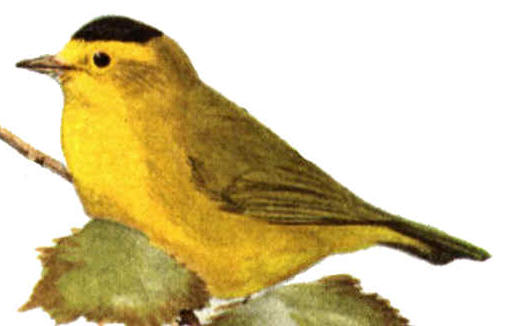 Family Parulidae Family Parulidae
Wilson’s Warbler
Wilsonia pusilla
Similar to yellow rumped
warbler but has a distinctive black cap. The back is yellow green
with yellow front and cheeks. Mainly an insectivore that eats
mostly adult larval invertebrates, but will eat berries. Small
slender bill. Female lays about 4-6 eggs. |
|
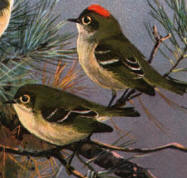 Family Regulidae Family Regulidae
Ruby-crowned kinglet
Rugulus calendula
The ruby-crowned kinglet is
a tiny, plump, active, nervous bird. It flicks its wings rapidly
while singing a high, thin tsee, or scolding je-dit je-dit.
It is grayish-olive above, with two white wing bars. The male
flashes its red crown patch when upset. |
|
 Family Sturnidae Family Sturnidae
European Starling
Sturnus
vulgaris
The starling is about 22 cm
in length with iridescent green glossy feathers covering the back,
nape and breast. Its legs are a reddish brown. It has a black
bill, except during mating season it is yellow. They are omnivores
eating seeds, insects, and fruits. Eggs are glossy light blue and
white. They have three clutches per year. |
|
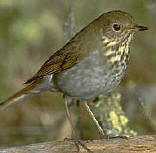 Family Turdidae Family Turdidae
Hermit Thrush
Catharus guttatus
Average length is 17 cm with a wingspan of 29
cm. This bird has a distinct white eye ring, indistinct whitish bar
over the lores, darkly spotted breast and sides of throat. Reddish
coloration on tail. Omnivores-eats insects, small invertebrates and
fruits. Female lays 3-6 eggs that are pale blue to blue-green with
brow flecks. |
|
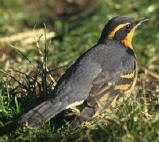 Family Turdidae Family Turdidae
Varied Thrush
Ixoreus naevius
The varied thrush is 19-26
cm long. The male is slate blue on its back and nape, with an
orange face. The female is dull with brownish-olive coloration. It
is an omnivore eating fruits, berries, acorns and arthropods. |
|
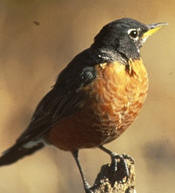 Family Turdidae (thrushes) Family Turdidae (thrushes)
American Robin
Turdus migratorius
Considered a large thrush 23-28 cm in length.
It is brown above, reddish on the breast, especially in males.
Throats are white, streaked with black. They are omnivores eating
fruits, earthworms, and insects. They are an effective pest
control. Cup shaped nests with mud on the inside. They lay 3-5
blue green eggs that are incubated by the female for about 14 days.
Robins are migratory, shifting south during the autumn. |
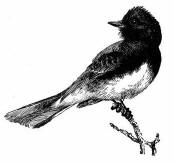 Family
Tyrannidae (tyrant flycatchers) Family
Tyrannidae (tyrant flycatchers)
Black Phoebe
Sayornis nigricans
The black phoebe is a
solitary flycatcher that feeds almost entirely on flying insects.
It perches in the open near water, wagging and spreading its tail.
It makes short flights to catch insects, and returns to its perch.
The top of its body, including the breast, is black; the belly is
white. Its 4-syllable song is a thin, rising pee-wee,
followed by a descending pee-wee. Its calls include a loud
tsee and a sharper tsip. It lays 3-6 white eggs in a
cup nest of mud and grass built beneath an overhanging cliff or
eave. |
|
Order Piciformes (woodpeckers) |
|
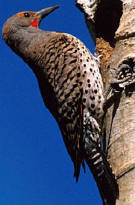 Family Picidae Family Picidae
Northern Flicker
Colaptes auratus
Brown above
with dark spots and bars with a black patch on its upper breast.
Face is gray with a red bar near the base of its peak. It has a
white rump that is visible during flight. It has a loud repeated
wik-wik-wik
or flicker-flicker-flicker |
|
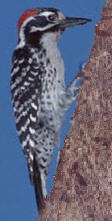 Family Picidae Family Picidae
Nuttall’s Woodpecker
Picoides nuttallii
Black with
white stripes on face. Male has a red crown. About 18-19 cm in
length. They excavate a nest in oak or cottonwood and female lays
about 3-6 white eggs. Their voice is a rolling call, prreep,
or sharp pit-it. |
|
Order Apodiformes (hummingbirds, swifts) |
|
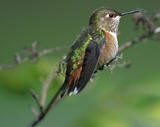 Family Trochilidae Family Trochilidae
Anna’s Hummingbird
Calypte anna
This
hummingbird is the largest California hummingbird and is the only
one commonly found here during midwinter. It is dark green above
and gray below. Males have a brilliant red crown and red-spotted
throat. Females often have a few red throat feathers and a
white-tipped tail. Its song, delivered from a perch, is a series of
squeaking, rasping notes; its call is a sharp chick. It lays
2 white eggs in a tiny lichen-covered cup fastened to a branch of a
tree or shrub. |
|
Order Columbiformes (doves, pigeons) |
|
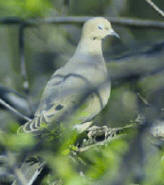 Family Columbidae Family Columbidae
Mourning Dove
Zenaida
macroura
This common
dove is gray-brown with a black spot on its cheeks. It has a slim
body, small head, pinkish feet, and a long pointed tail. The wings
produce a whistling sound as the dove takes flight and the white
tips of the outer tail feathers are visible. Small flocks are often
found feeding on the ground or perched on wires or tree branches.
Its flight is swift and direct without coasting. Its call is a
series of mournful coos. It lays 2 white eggs in nests in trees,
shrubs, or on the ground. |
WATER BIRDS
Order Anseriformes (ducks, geese) |
|
 Family Anatidae Family Anatidae
Mallard
Anas
platyrhynchos
Mallards have
a violet or blue wing patch (speculum) bordered with white. The
bill is light greenish-yellow in the male and yellow blotched with
black in the female. The hen (female) is mottled brown with a light
line above the eye. In breeding, the drake (male) has a plumage of
a bright green head, white color, reddish-brown chest, gray sides,
and black all around the base of the tail. |
|
Order Ciconiiformes (herons, egrets) |
|
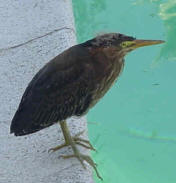 Family Ardeidae Family Ardeidae
Green Heron
Butorides
virescens
Adult green
herons are about the size of a crow (40 cm high) with a stocky build
and legs that are relatively short. They fly with their long beaks
and legs extended. Adult green herons have distinctive bluish-green
and reddish-brown coloration with gray under parts and a dark bill.
They forage along wooded shores from perches on snags or trees
close above the water. They build stick nests in the upper dense
tops of tall trees. They usually lay 2-4 eggs. Carnivores feeding
on fish and invertebrates with some rodents, lizards, frogs,
tadpoles, and snakes. |